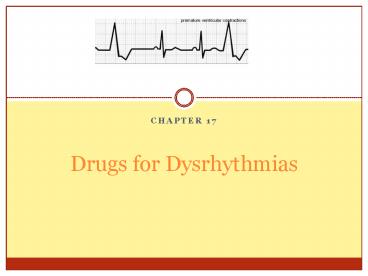Drugs for Dysrhythmias - PowerPoint PPT Presentation
1 / 24
Title:
Drugs for Dysrhythmias
Description:
... population is difficult to ascertain because many clients experience no symptoms. ... 10. Congested heart failure (CHF) The Electrical Conduction Pathway ... – PowerPoint PPT presentation
Number of Views:1568
Avg rating:3.0/5.0
Title: Drugs for Dysrhythmias
1
Drugs for Dysrhythmias
- Chapter 17
2
Introduction
- Dysrhythmias are abnormalities of electrical
conduction or rhythm in the heart. - Sometimes called arrhythmias, they encompass a
number of different disorders that range from
harmless to life threatening.
3
Introduction
- Proper diagnosis and optimum pharmacologic
treatment can significantly affect the frequency
of dysrhythmias and their consequences. - Fast Facts pg. 296
4
Introduction
- The frequency of dysrhythmias in the population
is difficult to ascertain because many clients
experience no symptoms.
5
Introduction
- Dysrhythmias are abnormalities of electrical
conduction or rhythm in the heart - Aka arrhythmias
- Can be harmless to life threatening
- Electrocardiogram (ECG/EKG) used to make
diagnosis - Persistent dysrhythmias increase risk of stroke
and heart failure - Severe dysrhythmias may cause sudden death
6
Classified by the Location Type of Rhythm
Produced
- Originate in atria (aka supraventricular)
- Premature atrial contractions (PACs)
- Atrial tachycardia
- Atrial flutter
- Atrial fibrillationmost common
- Originate in ventriclesmore serious
- Premature ventricular contractions (PVCs)more
serious than PACs - Ventricular tachycardia
- Ventricular flutter or fibrillationrequire
immediate treatment
7
Classified by the Location Type of Rhythm
- Sinus bradycardia and heart blocks may require
pacemaker
8
Disease Commonly R/T Dysrhythmias
- 1. HTN
- 2. Mitral stenosis
- 3. Coronary artery disease (CAD)
- 4. Medications such as digitalis
- 5. Low serum potassium levels
- 6. Myocardial infarction (MI)
- 7. Adverse effects from antidysrhythmic drug
- 8. Stoke (CVA)
- 9. Diabetes Mellitus (DM)
- 10. Congested heart failure (CHF)
9
The Electrical Conduction Pathway
- The electrical conductionpathway in the
myocardium keeps the heart beating in a
synchronized manner. - In all types of dysrhythmias there is a defect in
the formation or conduction of electrical
impulses across the myocardium.
10
The Electrical Conduction Pathway
- Normal conduction pathway in the heart
- Sinoatrial (SA) node
- Atrioventricular (AV) node
- Atrioventricular bundle (Bundle of His)
- Right and left bundle branches
- Purkinje fibers
11
The Electrical Conduction Pathway
- Electrocardiogram (ECG)measures this electrical
activity. - Ectopic foci or ectopic pacemakers
- Other areas of the heart start to initiate beats.
- Potential to cause dysrhythmias
12
The Electrical Conduction Pathway
- Goal of conduction system is to keep heart beat
in a regular synchronized manner to maintain
cardiac output.
13
Non-Pharmacologic Therapy
- Non-pharmacologic therapy of certain dysrhythmias
is often the treatment of choice. - All antidysrhythmic agents have the ability to
cause rhythm abnormalities or worsen existing
ones.
14
Non-Pharmacologic Therapy
- Because of this, non-pharmacologic treatment is
sometimes preferred over drug therapy. - Dysrhythmias may be corrected using cardioversion
or catheter ablation.
15
Non-Pharmacologic Therapy
- Cardioversion or defibrillation
- Electrical shock to heart
- Used for more serious dysrhythmias
- Catheter ablation
- Identification and destruction of myocardial
cells responsible for abnormal conduction - Cardiac pacemaker inserter
- Dysrhthmias that cause heart to beat to slowly
- Implantable cardioverter defibrillation
- Pacing the heart or
- Giving an electrical shock when dysrhthmia
occurs.
16
Changes in Na K Levels
- Changes in sodium and potassium levels generate
the action potential in myocardial cells. - Antidysrhthmic drugs affect the action potential
in myocardial cells. - They act by blocking sodium, potassium, or
calcium channels in the cell membranes.
17
Classified by Mechanism of Action
- All antidysrhythmic drugs can correct, worsen or
create new dysrhythmias. - Class Isodium channel blockers
- Class IIbeta-adrenergic blockers
- Class IIIpotassium channel blockers
- Class IVcalcium channel blockers
- Miscellaneous antidysrhythmic drugs.
18
Sodium Channel Blockers
- Sodium channel blockers slow the rate of impulse
conduction through the heart. - Largest group of antidysrhythmics
- Block opening of sodium ion channels in membrane
- Drug profile quinidine sulfate (Quinidex) pg. 304.
19
Beta-Adrenergic Blockers
- Beta-Adrenergic blockers reduce automaticity as
well as slow conduction velocity in the heart. - Used to treat large number of CV diseases.
- Serious side effects few used to treat
dysrhythmias - Slow heart heart
- Main valuetreat atrial dysrhthmias r/t heart
failure - DPpropranolol (Inderal) 305.
20
Potassium Channel Blockers
- Potassium channel blockers prolong the refractory
period of the heart. - Prolong duration of action potential
- Restricted use because of serious side effects
- DP amiodarone (Cardarone) pg. 306.
21
Calcium Channel Blockers
- Two calcium channel blockers are available as
antidysrhythmicstable 17.5 pg. 307. - Widely prescribed for various CV disorders
- Reduce automaticity in SA node and slow impulse
through AV node. - Only effective against supraventricular
dysrhythmias. - DPverapamil (Calan) pg. 307
22
Misc. Drugs
- Digoxin and several other drugs are used for
specific dysrhythmias but do not act by blocking
ion channelstable 17.6 pg. 308.
23
Misc. Drugs
- Digoxin
- Decrease automaticity of SA node and slows
conduction through AV node - Used for certain types of atrial dysrhthmias
- Can produce serious dysrhythmias
24
Misc. Drugs
- Adenosine (Adenocard)
- Slows conduction through AV node and decreases
automaticity of SA node. - Used to terminate serious atrial tachycardia.
- Side effects self-limiting due to short half-life

